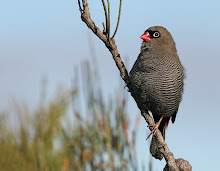After last year’s Lake Cargelligo flop the Drongos decided
that returning to the route we know best was the best way of trying to wrestle
our way out of third place. A brief reccie to Nyngan confirmed this suspicion
and on Twitchathon eve three of the team (the co-pilot, Max and I) gathered at
the usual starting point ready for our pre-race time trial. The weather was
feral and the birding rubbish (80 species) so our hopes for the main event were
low to say the least.
 |
| Our Painted Honeyeater site |
We woke to a glorious morning and after picking up our
fourth member Robbie we headed out for some last minute oiling. As we cruised
along the back roads I noticed a familiar looking bird perched above the road.
Swinging the car around revealed a Ground Cuckoo-shrike! Further observations
revealed a second bird and a nest!! What a corker to bag just before the race.
 |
| Diamond Firetail |
As 4pm approached, a female White-winged Triller was spotted
flying into a tall eucalypt and there it stayed, with four desperate observers
straining their necks, until the alarm went off and that rather dull little
girl became our first bird for the race. White-throated Gerygone, Brown
Treecreeper, Diamond Firetail and Fuscous Honeyeater were the next to fall.
Little Friarbird was heard and a Double-barred Finch flushed from the grass.
Wedgies, Tree Martin, Bee-eater and Dusky Woodswallow were seen soaring above.
Rufous Songlark were very vocal and a brief glimpse of a Turquoise Parrot was a
relief. A well oiled pair of White-bellied Cuckoo-shrike on nest was our last
sighting here.
 |
| Jakcy Winter |
We zipped along picking up Little Raven, Banded Lapwing,
Little Corella and Grey-crowned Babbler along the way. A Plum-headed Finch was
fluked and nervous waiting finally revealed a Painted Honeyeater calling and a
Singing Honeyeater feeding in mistletoe. A bit further up the road and two
biggies fell, White-backed Swallow and Horsfield’s Bushlark. A White-winged
Fairy-wren was seen in the usual place but we dipped on Yellow-throated Miner.
A Spotted Harrier glided past and the Co-pilot somehow managed to hear a
Cockatiel at a 100kph! Ground Cuckoo-shrike, Blue Bonnet and Zebra Finch were
easily seen but we dipped on Red-capped Robin and Spotted Bowerbird.
 |
| Leard State Forest - future open cut mine |
We entered Leard State Forest and quickly picked up a swag
of western woodland species like Leaden and Restless Flycatcher, Varied
Sittella, Speckled Warbler, Chestnut-rumped Thornbill, Brown-headed Honeyeater,
Western Gerygone and Common Bronzewing. We then swung the car around and headed
for Boggabri. We didn’t need to leave the main street to get our targets,
Blackbird, Brown Honeyeater and Musk Lorikeet. With the sun nearly gone we made
a dash for Gunnedah and with minutes to spare Pink-eared and Blue-billed Duck
made the list.
Our night time drive was pretty uneventful with only the big
three night birds recorded, Barn Owl, Southern Boobook and Tawny Frogmouth.
Masked Lapwing and Cattle Egret were spot lit bringing our Saturday total to
114 species.
 |
| Bassian Thrush |
 |
| Superb Lyrebird |
After another uncomfortable night on the ground we awoke to
a subdued dawn chorus but slowly the list started to grow. Pitta, Russet-tailed
Thrush, Spectacled Monarch, Wompoo Fruit-dove, White-headed Pigeon, Brown
Cuckoo-dove, Catbird and Yellow-throated Scrubwren were heard and seen. A
Red-browed Treecreeper was the highlight as we crossed over the ridge, where on
the other side we saw Brush Turkey, Crimson Rosella and Bassian Thrush.
Phesant Coucal, Variegated Fairy-wren and Koel were recorded
on the drive down to Dungog. Long-billed Corella was seen south of town.
Clarence Town only revealed Scarlet Honeyeater, whilst Seaham came through with
the goods….Yellow-billed Spoonbill, Nankeen Night Heron and Scaly-breasted
Lorikeet. Green Wattle Creek only produced White-naped Honeyeater, not an easy
bird to get during the Twitch.
Geoff proved quite difficult to locate in the Terrace and it
wont be long before a new location might be needed. Musk Duck and Great-crested
Grebe were seen at our ‘New Walka’. We arrived at Stockton Sandspit to find the
tide still quite high so we decided to leave and come back in an hours time.
Tattlers and Tereks were seen in Fern Bay and Golden Plovers along the Stocko
foreshore.
 |
| Brown Quail |
The Baths were exceptionally quiet with only Crested Tern,
Sooty Oystercatcher and Wedge-tailed Shearwater seen. We then headed west to
Hexham Swamp where the waders of the previous week had disappeared but Brown
Quail and Little Egret were welcome sights. Ash Island was quite good and we
managed some beauties like White-fronted Chat, Brown Songlark, Sharp-tailed
Sandpiper, Osprey and Brown Goshawk.
 |
| Pied Oystercatcher |
Back to the Sandspit and there were the waders! In a very
quick space of time we saw Bar-tailed and Black-tailed Godwit, Curlew,
Whimbrel, Red Knot, Stint, Curlew Sandpiper, Pied Oystercatcher and Gull-billed
Tern. It was at this point that a quick count put the wind in our sails….212!
Next was Lenaghans which produced Glossy Ibis,
Channel-billed Cuckoo, Latham’s Snipe and Topknot Pigeon. Over the range we
dipped on Jacana and most of the woodland birds we were relying on but
Yellow-tufted Honeyeaters were present in numbers. We then drove to our One
Bird Town where we saw Goldfinch. Our final stop was the Wetlands
Centre….Magpie Goose, Wandering Whistling-duck, White-cheeked Honeyeater and
our final bird for the day, Tawny Grassbird.
We had managed to equal our highest score of 223 species and
raise over $600 for the Cowra Woodland.


The Diamond Firetails are beautiful - as is the lyrebird. I am yet to see either of these! Great photos & recount.
ReplyDelete